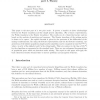Free Online Productivity Tools
i2Speak
i2Symbol
i2OCR
iTex2Img
iWeb2Print
iWeb2Shot
i2Type
iPdf2Split
iPdf2Merge
i2Bopomofo
i2Arabic
i2Style
i2Image
i2PDF
iLatex2Rtf
Sci2ools
EC
1998
1998
The Simple Genetic Algorithm and the Walsh Transform: Part I, Theory
This paper is the first part of a two part series. It proves a number of direct relationships between the Fourier transform and the simple genetic algorithm. (For a binary representation, the Walsh transform is the Fourier transform.) The results are of a theoretical nature and are based on the analysis of mutation and crossover. The Fourier transform of the mixing matrix is shown to be sparse. An explicit formula is given for the spectrum of the differential of the mixing transformation. By using the Fourier representation and the fast Fourier transform, one generation of the infinite population simple genetic algorithm can be computed in time O(c log2 3), where c is arity of the alphabet and is the string length. This is in contrast to the time of O(c3 ) for the algorithm as represented in the standard basis. There are two orthogonal decompositions of population space which are invariant under mixing. The sequel to this paper will apply the basic theoretical results obtained here...
| Added | 22 Dec 2010 |
| Updated | 22 Dec 2010 |
| Type | Journal |
| Year | 1998 |
| Where | EC |
| Authors | Michael D. Vose, Alden H. Wright |
Comments (0)

